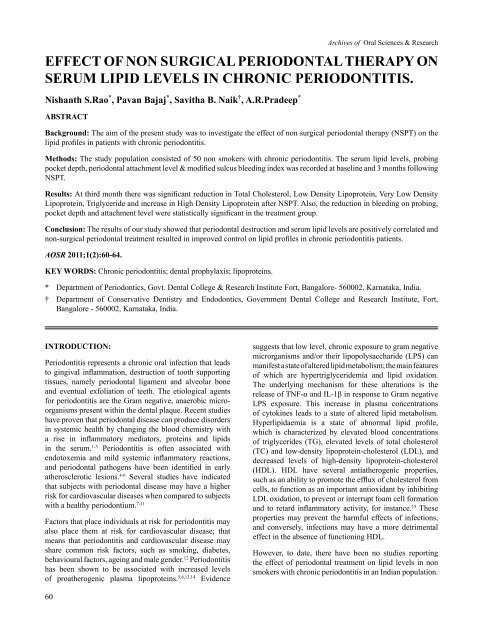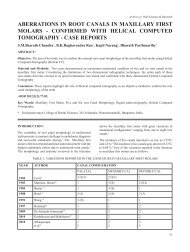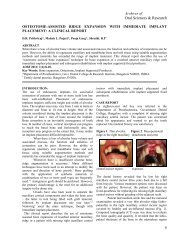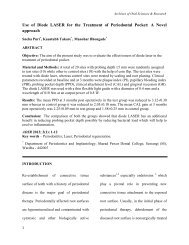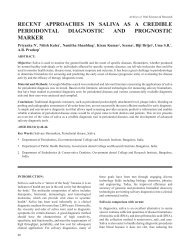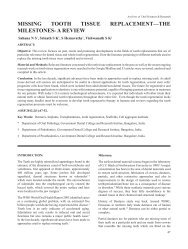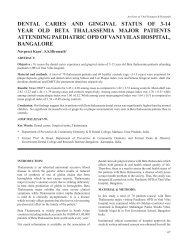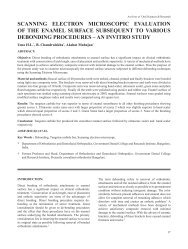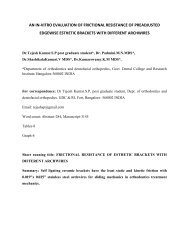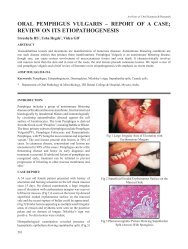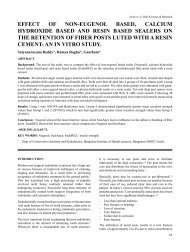effect of non surgical periodontal therapy on serum lipid ... - Aosr.co.in
effect of non surgical periodontal therapy on serum lipid ... - Aosr.co.in
effect of non surgical periodontal therapy on serum lipid ... - Aosr.co.in
You also want an ePaper? Increase the reach of your titles
YUMPU automatically turns print PDFs into web optimized ePapers that Google loves.
EFFECT OF NON SURGICAL PERIODONTAL THERAPY ON<br />
SERUM LIPID LEVELS IN CHRONIC PERIODONTITIS.<br />
Nishanth S.Rao * , Pavan Bajaj * , Savitha B. Naik † , A.R.Pradeep *<br />
ABSTRACT<br />
Background: The aim <str<strong>on</strong>g>of</str<strong>on</strong>g> the present study was to <strong>in</strong>vestigate the <str<strong>on</strong>g>effect</str<strong>on</strong>g> <str<strong>on</strong>g>of</str<strong>on</strong>g> <str<strong>on</strong>g>n<strong>on</strong></str<strong>on</strong>g> <str<strong>on</strong>g>surgical</str<strong>on</strong>g> <str<strong>on</strong>g>period<strong>on</strong>tal</str<strong>on</strong>g> <str<strong>on</strong>g>therapy</str<strong>on</strong>g> (NSPT) <strong>on</strong> the<br />
<strong>lipid</strong> pr<str<strong>on</strong>g>of</str<strong>on</strong>g>iles <strong>in</strong> patients with chr<strong>on</strong>ic period<strong>on</strong>titis.<br />
Methods: The study populati<strong>on</strong> c<strong>on</strong>sisted <str<strong>on</strong>g>of</str<strong>on</strong>g> 50 <str<strong>on</strong>g>n<strong>on</strong></str<strong>on</strong>g> smokers with chr<strong>on</strong>ic period<strong>on</strong>titis. The <strong>serum</strong> <strong>lipid</strong> levels, prob<strong>in</strong>g<br />
pocket depth, <str<strong>on</strong>g>period<strong>on</strong>tal</str<strong>on</strong>g> attachment level & modified sulcus bleed<strong>in</strong>g <strong>in</strong>dex was re<strong>co</strong>rded at basel<strong>in</strong>e and 3 m<strong>on</strong>ths follow<strong>in</strong>g<br />
NSPT.<br />
Results: At third m<strong>on</strong>th there was significant reducti<strong>on</strong> <strong>in</strong> Total Cholesterol, Low Density Lipoprote<strong>in</strong>, Very Low Density<br />
Lipoprote<strong>in</strong>, Triglyceride and <strong>in</strong>crease <strong>in</strong> High Density Lipoprote<strong>in</strong> after NSPT. Also, the reducti<strong>on</strong> <strong>in</strong> bleed<strong>in</strong>g <strong>on</strong> prob<strong>in</strong>g,<br />
pocket depth and attachment level were statistically significant <strong>in</strong> the treatment group.<br />
C<strong>on</strong>clusi<strong>on</strong>: The results <str<strong>on</strong>g>of</str<strong>on</strong>g> our study showed that <str<strong>on</strong>g>period<strong>on</strong>tal</str<strong>on</strong>g> destructi<strong>on</strong> and <strong>serum</strong> <strong>lipid</strong> levels are positively <strong>co</strong>rrelated and<br />
<str<strong>on</strong>g>n<strong>on</strong></str<strong>on</strong>g>-<str<strong>on</strong>g>surgical</str<strong>on</strong>g> <str<strong>on</strong>g>period<strong>on</strong>tal</str<strong>on</strong>g> treatment resulted <strong>in</strong> improved c<strong>on</strong>trol <strong>on</strong> <strong>lipid</strong> pr<str<strong>on</strong>g>of</str<strong>on</strong>g>iles <strong>in</strong> chr<strong>on</strong>ic period<strong>on</strong>titis patients.<br />
AOSR 2011;1(2):60-64.<br />
KEY WORDS: Chr<strong>on</strong>ic period<strong>on</strong>titis; dental prophylaxis; lipoprote<strong>in</strong>s.<br />
Archives <str<strong>on</strong>g>of</str<strong>on</strong>g> Oral Sciences & Research<br />
* Department <str<strong>on</strong>g>of</str<strong>on</strong>g> Period<strong>on</strong>tics, Govt. Dental College & Research Institute Fort, Bangalore- 560002, Karnataka, India.<br />
† Department <str<strong>on</strong>g>of</str<strong>on</strong>g> C<strong>on</strong>servative Dentistry and Endod<strong>on</strong>tics, Government Dental College and Research Institute, Fort,<br />
Bangalore - 560002, Karnataka, India.<br />
INTRODUCTION:<br />
Period<strong>on</strong>titis represents a chr<strong>on</strong>ic oral <strong>in</strong>fecti<strong>on</strong> that leads<br />
to g<strong>in</strong>gival <strong>in</strong>flammati<strong>on</strong>, destructi<strong>on</strong> <str<strong>on</strong>g>of</str<strong>on</strong>g> tooth support<strong>in</strong>g<br />
tissues, namely <str<strong>on</strong>g>period<strong>on</strong>tal</str<strong>on</strong>g> ligament and alveolar b<strong>on</strong>e<br />
and eventual exfoliati<strong>on</strong> <str<strong>on</strong>g>of</str<strong>on</strong>g> teeth. The etiological agents<br />
for period<strong>on</strong>titis are the Gram negative, anaerobic microorganisms<br />
present with<strong>in</strong> the dental plaque. Recent studies<br />
have proven that <str<strong>on</strong>g>period<strong>on</strong>tal</str<strong>on</strong>g> disease can produce disorders<br />
<strong>in</strong> systemic health by chang<strong>in</strong>g the blood chemistry with<br />
a rise <strong>in</strong> <strong>in</strong>flammatory mediators, prote<strong>in</strong>s and <strong>lipid</strong>s<br />
<strong>in</strong> the <strong>serum</strong>. 1-3 Period<strong>on</strong>titis is <str<strong>on</strong>g>of</str<strong>on</strong>g>ten associated with<br />
endotoxemia and mild systemic <strong>in</strong>flammatory reacti<strong>on</strong>s,<br />
and <str<strong>on</strong>g>period<strong>on</strong>tal</str<strong>on</strong>g> pathogens have been identified <strong>in</strong> early<br />
atherosclerotic lesi<strong>on</strong>s. 4-6 Several studies have <strong>in</strong>dicated<br />
that subjects with <str<strong>on</strong>g>period<strong>on</strong>tal</str<strong>on</strong>g> disease may have a higher<br />
risk for cardiovascular diseases when <strong>co</strong>mpared to subjects<br />
with a healthy period<strong>on</strong>tium. 7-11<br />
Factors that place <strong>in</strong>dividuals at risk for period<strong>on</strong>titis may<br />
also place them at risk for cardiovascular disease; that<br />
means that period<strong>on</strong>titis and cardiovascular disease may<br />
share <strong>co</strong>mm<strong>on</strong> risk factors, such as smok<strong>in</strong>g, diabetes,<br />
behavioural factors, age<strong>in</strong>g and male gender. 12 Period<strong>on</strong>titis<br />
has been shown to be associated with <strong>in</strong>creased levels<br />
<str<strong>on</strong>g>of</str<strong>on</strong>g> proatherogenic plasma lipoprote<strong>in</strong>s. 5,6,13,14 Evidence<br />
suggests that low level, chr<strong>on</strong>ic exposure to gram negative<br />
microrganisms and/or their lipopolysaccharide (LPS) can<br />
manifest a state <str<strong>on</strong>g>of</str<strong>on</strong>g> altered <strong>lipid</strong> metabolism; the ma<strong>in</strong> features<br />
<str<strong>on</strong>g>of</str<strong>on</strong>g> which are hypertriglyceridemia and <strong>lipid</strong> oxidati<strong>on</strong>.<br />
The underly<strong>in</strong>g mechanism for these alterati<strong>on</strong>s is the<br />
release <str<strong>on</strong>g>of</str<strong>on</strong>g> TNF-α and IL-1β <strong>in</strong> resp<strong>on</strong>se to Gram negative<br />
LPS exposure. This <strong>in</strong>crease <strong>in</strong> plasma c<strong>on</strong>centrati<strong>on</strong>s<br />
<str<strong>on</strong>g>of</str<strong>on</strong>g> cytok<strong>in</strong>es leads to a state <str<strong>on</strong>g>of</str<strong>on</strong>g> altered <strong>lipid</strong> metabolism.<br />
Hyper<strong>lipid</strong>aemia is a state <str<strong>on</strong>g>of</str<strong>on</strong>g> abnormal <strong>lipid</strong> pr<str<strong>on</strong>g>of</str<strong>on</strong>g>ile,<br />
which is characterized by elevated blood c<strong>on</strong>centrati<strong>on</strong>s<br />
<str<strong>on</strong>g>of</str<strong>on</strong>g> triglycerides (TG), elevated levels <str<strong>on</strong>g>of</str<strong>on</strong>g> total cholesterol<br />
(TC) and low-density lipoprote<strong>in</strong>-cholesterol (LDL), and<br />
decreased levels <str<strong>on</strong>g>of</str<strong>on</strong>g> high-density lipoprote<strong>in</strong>-cholesterol<br />
(HDL). HDL have several antiatherogenic properties,<br />
such as an ability to promote the efflux <str<strong>on</strong>g>of</str<strong>on</strong>g> cholesterol from<br />
cells, to functi<strong>on</strong> as an important antioxidant by <strong>in</strong>hibit<strong>in</strong>g<br />
LDL oxidati<strong>on</strong>, to prevent or <strong>in</strong>terrupt foam cell formati<strong>on</strong><br />
and to retard <strong>in</strong>flammatory activity, for <strong>in</strong>stance. 15 These<br />
properties may prevent the harmful <str<strong>on</strong>g>effect</str<strong>on</strong>g>s <str<strong>on</strong>g>of</str<strong>on</strong>g> <strong>in</strong>fecti<strong>on</strong>s,<br />
and c<strong>on</strong>versely, <strong>in</strong>fecti<strong>on</strong>s may have a more detrimental<br />
<str<strong>on</strong>g>effect</str<strong>on</strong>g> <strong>in</strong> the absence <str<strong>on</strong>g>of</str<strong>on</strong>g> functi<strong>on</strong><strong>in</strong>g HDL.<br />
However, to date, there have been no studies report<strong>in</strong>g<br />
the <str<strong>on</strong>g>effect</str<strong>on</strong>g> <str<strong>on</strong>g>of</str<strong>on</strong>g> <str<strong>on</strong>g>period<strong>on</strong>tal</str<strong>on</strong>g> treatment <strong>on</strong> <strong>lipid</strong> levels <strong>in</strong> <str<strong>on</strong>g>n<strong>on</strong></str<strong>on</strong>g><br />
smokers with chr<strong>on</strong>ic period<strong>on</strong>titis <strong>in</strong> an Indian populati<strong>on</strong>.<br />
60
N<strong>on</strong>-<str<strong>on</strong>g>surgical</str<strong>on</strong>g> <str<strong>on</strong>g>period<strong>on</strong>tal</str<strong>on</strong>g> <str<strong>on</strong>g>therapy</str<strong>on</strong>g> & <strong>lipid</strong> levels<br />
Hence, the aim <str<strong>on</strong>g>of</str<strong>on</strong>g> the present study was to <strong>in</strong>vestigate the<br />
<str<strong>on</strong>g>effect</str<strong>on</strong>g> <str<strong>on</strong>g>of</str<strong>on</strong>g> <str<strong>on</strong>g>n<strong>on</strong></str<strong>on</strong>g> <str<strong>on</strong>g>surgical</str<strong>on</strong>g> <str<strong>on</strong>g>period<strong>on</strong>tal</str<strong>on</strong>g> <str<strong>on</strong>g>therapy</str<strong>on</strong>g> (NSPT) <strong>on</strong> the<br />
<strong>lipid</strong> levels <strong>in</strong> <str<strong>on</strong>g>n<strong>on</strong></str<strong>on</strong>g> smokers with chr<strong>on</strong>ic period<strong>on</strong>tits.<br />
MATERIAL AND METHODS<br />
Subjects:<br />
The subjects for the study were selected from patients<br />
who attended the Outpatient Secti<strong>on</strong>, Department <str<strong>on</strong>g>of</str<strong>on</strong>g><br />
Period<strong>on</strong>tics, Government Dental College and Research<br />
Institute, Bangalore, from February 2010 to June 2010.<br />
The Ethics Committee and Review Board <str<strong>on</strong>g>of</str<strong>on</strong>g> Government<br />
Dental College & Research Institute, Bangalore approved<br />
the study proto<strong>co</strong>l. The proto<strong>co</strong>l was clearly expla<strong>in</strong>ed to<br />
all the patients and <strong>in</strong>formed c<strong>on</strong>sent was obta<strong>in</strong>ed from all<br />
recruits. Smok<strong>in</strong>g history was <strong>co</strong>llected by means <str<strong>on</strong>g>of</str<strong>on</strong>g> selfreport<strong>in</strong>g<br />
follow<strong>in</strong>g a standardized questi<strong>on</strong>naire. Subjects<br />
were classified as smokers and <str<strong>on</strong>g>n<strong>on</strong></str<strong>on</strong>g> smokers based <strong>on</strong><br />
criteria established by the Centre for Disease C<strong>on</strong>trol and<br />
preventi<strong>on</strong> (CDC), “current smokers” were def<strong>in</strong>ed as those<br />
who had smoked 100 or more cigarettes over their lifetime<br />
and smoked at the time <str<strong>on</strong>g>of</str<strong>on</strong>g> <strong>in</strong>terview; “former smokers” had<br />
smoked 100 or more cigarettes over their lifetime but were<br />
not currently smok<strong>in</strong>g; and “<str<strong>on</strong>g>n<strong>on</strong></str<strong>on</strong>g> smokers” had not smoked<br />
100 or more cigarettes over their lifetime. Former smokers<br />
and current smokers were excluded from the study. All<br />
subjects with more than 3 pockets with a prob<strong>in</strong>g pocket<br />
depth (PPD) ≥ 4 mm or with a <str<strong>on</strong>g>period<strong>on</strong>tal</str<strong>on</strong>g> attachment<br />
level (PAL) ≥ 3mm were <strong>in</strong>cluded <strong>in</strong> the study. The study<br />
populati<strong>on</strong> c<strong>on</strong>sisted <str<strong>on</strong>g>of</str<strong>on</strong>g> 50 <str<strong>on</strong>g>n<strong>on</strong></str<strong>on</strong>g>-smokers (24 females and<br />
26 males) with chr<strong>on</strong>ic period<strong>on</strong>titis (mean age: 34.79<br />
+ 6.17). Body weight was assessed by us<strong>in</strong>g body mass<br />
<strong>in</strong>dex (BMI) and <strong>on</strong>ly <str<strong>on</strong>g>n<strong>on</strong></str<strong>on</strong>g> obese <strong>in</strong>dividuals (BMI: 18-<br />
22.9 Kg/m2) were enrolled <strong>in</strong> the study. The exclusi<strong>on</strong><br />
criteria for the study were dental treatment dur<strong>in</strong>g the past<br />
6 m<strong>on</strong>ths, smok<strong>in</strong>g, al<strong>co</strong>holics, pregnant, lactat<strong>in</strong>g and<br />
post menopausal women, aggressive period<strong>on</strong>titis, cardiac<br />
diseases, rheumatoid arthritis, obesity, patients tak<strong>in</strong>g any<br />
drug aga<strong>in</strong>st hypercholesterolaemia and any other systemic<br />
disease which can alter the <strong>co</strong>urse <str<strong>on</strong>g>of</str<strong>on</strong>g> <str<strong>on</strong>g>period<strong>on</strong>tal</str<strong>on</strong>g> disease or<br />
<strong>serum</strong> <strong>lipid</strong> levels.<br />
Measurement <str<strong>on</strong>g>of</str<strong>on</strong>g> <strong>serum</strong> <strong>lipid</strong>s:<br />
Serum <strong>lipid</strong>s were determ<strong>in</strong>ed <strong>in</strong> the Infosys laboratory,<br />
Victoria Hospital us<strong>in</strong>g rout<strong>in</strong>e enzymatic methods. To<br />
identify subjects with pathologic values, the follow<strong>in</strong>g<br />
cut<str<strong>on</strong>g>of</str<strong>on</strong>g>f po<strong>in</strong>ts were used ac<strong>co</strong>rd<strong>in</strong>g to the laboratory’s<br />
re<strong>co</strong>mmendati<strong>on</strong>: TC > 200 mg/dL, LDL > 130 mg/dL,<br />
HDL < 35 mg/dL, VLDL > 40 mg/dL and TG > 200 mg/<br />
dL. The <strong>serum</strong> <strong>lipid</strong> levels was re<strong>co</strong>rded at basel<strong>in</strong>e (day 0)<br />
and 3 m<strong>on</strong>ths follow<strong>in</strong>g the scal<strong>in</strong>g and root plan<strong>in</strong>g.<br />
*<br />
Hu-Friedy, Chicago, IL, USA.<br />
†<br />
SPSS statistical package versi<strong>on</strong> 17, SPSS Inc., Chicago, IL, USA.<br />
Period<strong>on</strong>tal parameters:<br />
All subjects were exam<strong>in</strong>ed by the same exam<strong>in</strong>er. All<br />
<str<strong>on</strong>g>period<strong>on</strong>tal</str<strong>on</strong>g> parameters were assessed at 6 different sites<br />
around each tooth (Mesio-buccal, Buccal, Disto-buccal,<br />
Mesio-l<strong>in</strong>gual, L<strong>in</strong>gual and Disto-l<strong>in</strong>gual). The exam<strong>in</strong><strong>in</strong>g<br />
<strong>in</strong>vestigator was unaware <str<strong>on</strong>g>of</str<strong>on</strong>g> the group assignments. The<br />
parameters assessed were: PPD, PAL & modified sulcus<br />
bleed<strong>in</strong>g <strong>in</strong>dex (mSBI). PPD & PAL assessments were<br />
carried out with the UNC 15 probe * with 1mm graduati<strong>on</strong>s.<br />
The <str<strong>on</strong>g>period<strong>on</strong>tal</str<strong>on</strong>g> parameters were re<strong>co</strong>rded at basel<strong>in</strong>e (day<br />
0) and 3 m<strong>on</strong>ths follow<strong>in</strong>g the scal<strong>in</strong>g and root plan<strong>in</strong>g.<br />
The patients received oral hygiene <strong>in</strong>structi<strong>on</strong>s and fullmouth<br />
scal<strong>in</strong>g and root plan<strong>in</strong>g (NSPT) performed under<br />
local anaesthesia after re<strong>co</strong>rd<strong>in</strong>g the basel<strong>in</strong>e parameters.<br />
STATISTICAL METHODS:<br />
Data are presented as mean and standard deviati<strong>on</strong>.<br />
Differences between means were proved for significance<br />
us<strong>in</strong>g the Student’s t-test. The data were analyzed us<strong>in</strong>g<br />
statistical s<str<strong>on</strong>g>of</str<strong>on</strong>g>tware. †<br />
RESULTS:<br />
Table 1 dem<strong>on</strong>strates the demographic data and patient<br />
characteristics <str<strong>on</strong>g>of</str<strong>on</strong>g> the study populati<strong>on</strong>. The <strong>lipid</strong> levels<br />
were determ<strong>in</strong>ed for <str<strong>on</strong>g>n<strong>on</strong></str<strong>on</strong>g> smokers at basel<strong>in</strong>e and at<br />
end <str<strong>on</strong>g>of</str<strong>on</strong>g> 3 m<strong>on</strong>ths. As shown <strong>in</strong> Table 2, there was<br />
significant reducti<strong>on</strong> <strong>in</strong> the TC, LDL, VLDL and TG<br />
at the end <str<strong>on</strong>g>of</str<strong>on</strong>g> 3 m<strong>on</strong>ths after NSPT. Also there was a<br />
statistically significant <strong>in</strong>crease <strong>in</strong> HDL after NSPT. The<br />
cl<strong>in</strong>ical <str<strong>on</strong>g>period<strong>on</strong>tal</str<strong>on</strong>g> parameters also showed significant<br />
improvement after treatment. Thus suggest<strong>in</strong>g that<br />
<str<strong>on</strong>g>period<strong>on</strong>tal</str<strong>on</strong>g> destructi<strong>on</strong> and higher TC, LDL, VLDL and<br />
TG are positively <strong>co</strong>rrelated, while HDL is positively<br />
<strong>co</strong>rrelated with <str<strong>on</strong>g>period<strong>on</strong>tal</str<strong>on</strong>g> health.<br />
Table 1. Characteristics <str<strong>on</strong>g>of</str<strong>on</strong>g> the study subjects<br />
Characteristic N= 50<br />
Age (mean+ S.D.) 34.79 + 6.17<br />
Male (%) 52<br />
Female (%) 48<br />
Body Mass Index<br />
(mean + S.D.)<br />
20.41 + 1.53<br />
Daily brush<strong>in</strong>g<br />
habit (times/day) (%)<br />
0 times/day 2<br />
1 time/day 76<br />
2 times/day 22<br />
61
Nishanth S.Rao et al.<br />
DISCUSSION:<br />
Cor<strong>on</strong>ary heart disease has be<strong>co</strong>me a public health<br />
problem and major cause <str<strong>on</strong>g>of</str<strong>on</strong>g> death, both <strong>in</strong> developed and<br />
develop<strong>in</strong>g <strong>co</strong>untries. 16,17 There is <strong>in</strong>creas<strong>in</strong>g c<strong>on</strong>cern about<br />
the blood <strong>lipid</strong> levels, as a risk factor for the development <str<strong>on</strong>g>of</str<strong>on</strong>g><br />
<strong>co</strong>r<strong>on</strong>ary heart disease. Studies have also shown a positive<br />
<strong>co</strong>rrelati<strong>on</strong> between period<strong>on</strong>titis and <strong>in</strong>creased <strong>serum</strong><br />
<strong>lipid</strong> pr<str<strong>on</strong>g>of</str<strong>on</strong>g>ile. 5,12,13,18,19 Changes <strong>in</strong> c<strong>on</strong>centrati<strong>on</strong>s <str<strong>on</strong>g>of</str<strong>on</strong>g> these<br />
markers have also been associated with acute and chr<strong>on</strong>ic<br />
<strong>in</strong>fecti<strong>on</strong>s, and <strong>in</strong> this respect, bacterial <strong>in</strong>fecti<strong>on</strong>s have<br />
been implicated as a possible risk factor <strong>in</strong> the etiology <str<strong>on</strong>g>of</str<strong>on</strong>g><br />
<strong>co</strong>r<strong>on</strong>ary heart disease. 5,20<br />
* P value < 0.05 significant<br />
Table 2: Comparis<strong>on</strong> <str<strong>on</strong>g>of</str<strong>on</strong>g> variables at basel<strong>in</strong>e and 3 m<strong>on</strong>ths<br />
N<strong>on</strong>-smokers (n=50)<br />
Basel<strong>in</strong>e 3 m<strong>on</strong>ths P value<br />
Total cholesterol 167.48 + 10.42 142.07 + 7.16 0.001*<br />
HDL 38.83 + 2.39 40.48 + 2.57 0.001*<br />
LDL 117.97 + 10.43 99.38 + 3.18 0.001*<br />
VLDL 26.76 + 3.64 25.10 + 3.38 0.001*<br />
Triglyceride 142.97 + 9.65 140.62 + 10.13 0.002*<br />
Prob<strong>in</strong>g pocket depth 4.95 + 0.36 3.76 + 0.46 0.001*<br />
Period<strong>on</strong>tal attachment<br />
level<br />
4.48 + 0.35 3.75 + 0.38 0.001*<br />
Modified sulcus<br />
bleed<strong>in</strong>g <strong>in</strong>dex<br />
2.96 + 0.35 1.85 + 0.25 0.001*<br />
Data <str<strong>on</strong>g>of</str<strong>on</strong>g> our study suggests that period<strong>on</strong>titis may trigger<br />
alterati<strong>on</strong>s <strong>in</strong> <strong>lipid</strong> levels by possibly elicit<strong>in</strong>g an <strong>in</strong>creased<br />
systemic <strong>in</strong>flammatory resp<strong>on</strong>se. The data <str<strong>on</strong>g>of</str<strong>on</strong>g> the present<br />
study <strong>in</strong>dicate that period<strong>on</strong>titis causes changes <strong>in</strong> <strong>serum</strong><br />
TC, HDL, LDL, VLDL and TG levels. Period<strong>on</strong>titis is a<br />
chr<strong>on</strong>ic, <strong>in</strong>flammatory, destructive disease that affects the<br />
support<strong>in</strong>g tissues <str<strong>on</strong>g>of</str<strong>on</strong>g> the teeth, and is <str<strong>on</strong>g>of</str<strong>on</strong>g>ten associated with<br />
enhanced c<strong>on</strong>centrati<strong>on</strong>s <str<strong>on</strong>g>of</str<strong>on</strong>g> proatherogenic plasma <strong>lipid</strong>s,<br />
i.e., TC and LDL as well as TG. 12,13,19 The out<strong>co</strong>mes <str<strong>on</strong>g>of</str<strong>on</strong>g><br />
our study support this overall c<strong>on</strong>clusi<strong>on</strong>. But most <str<strong>on</strong>g>of</str<strong>on</strong>g> the<br />
above menti<strong>on</strong>ed studies were unable to <strong>in</strong>fer a positive<br />
<strong>co</strong>rrelati<strong>on</strong> with all the parameters <str<strong>on</strong>g>of</str<strong>on</strong>g> <strong>lipid</strong> pr<str<strong>on</strong>g>of</str<strong>on</strong>g>ile (i.e.<br />
TC, HDL, LDL, VLDL and TG) to arrive at a def<strong>in</strong>itive<br />
c<strong>on</strong>clusi<strong>on</strong> <strong>on</strong> the associati<strong>on</strong> between period<strong>on</strong>titis and<br />
<strong>in</strong>creased <strong>lipid</strong> pr<str<strong>on</strong>g>of</str<strong>on</strong>g>ile.<br />
Lösche W. et al. 5 found <strong>on</strong>ly LDL to be significantly<br />
associated with the cl<strong>in</strong>ical parameters <str<strong>on</strong>g>of</str<strong>on</strong>g> <strong>in</strong>flammati<strong>on</strong><br />
and <str<strong>on</strong>g>period<strong>on</strong>tal</str<strong>on</strong>g> tissue destructi<strong>on</strong> <strong>in</strong> period<strong>on</strong>titis subjects.<br />
Iacap<strong>in</strong>o and Cutler 21 reported that existence <str<strong>on</strong>g>of</str<strong>on</strong>g> an<br />
associati<strong>on</strong> between period<strong>on</strong>titis and <strong>serum</strong> <strong>lipid</strong> levels<br />
does not establish whether <str<strong>on</strong>g>period<strong>on</strong>tal</str<strong>on</strong>g> disease causes<br />
elevati<strong>on</strong>s <strong>in</strong> <strong>lipid</strong> levels or whether elevati<strong>on</strong>s <strong>in</strong> <strong>serum</strong><br />
<strong>lipid</strong>s predispose to period<strong>on</strong>titis. Hence these studies <strong>in</strong><br />
actual fact do not depict a str<strong>on</strong>g <strong>co</strong>rrelati<strong>on</strong> between <strong>serum</strong><br />
<strong>lipid</strong> levels and <str<strong>on</strong>g>period<strong>on</strong>tal</str<strong>on</strong>g> disease. One possible reas<strong>on</strong> to<br />
expla<strong>in</strong> the differences between the results <str<strong>on</strong>g>of</str<strong>on</strong>g> this study<br />
and previous studies is the difference <strong>in</strong> how period<strong>on</strong>titis<br />
is def<strong>in</strong>ed. We def<strong>in</strong>ed chr<strong>on</strong>ic period<strong>on</strong>titis as subjects<br />
with more than 3 pockets with a prob<strong>in</strong>g depth ≥ 4 mm<br />
and PAL≥ 3mm whereas Katz et al 13 for example, used<br />
CPITN s<strong>co</strong>res for determ<strong>in</strong><strong>in</strong>g period<strong>on</strong>titis. A possible<br />
explanati<strong>on</strong> for the associati<strong>on</strong> between hyper<strong>lipid</strong>aemia<br />
and <str<strong>on</strong>g>period<strong>on</strong>tal</str<strong>on</strong>g> <strong>in</strong>fecti<strong>on</strong> was postulated by Noack et al 22<br />
by assess<strong>in</strong>g neutrophil respiratory burst by whole blood<br />
chemilum<strong>in</strong>escence and they found significant <strong>in</strong>creases<br />
<strong>in</strong> both chemilum<strong>in</strong>escence and pocket depth <strong>on</strong> a group<br />
<str<strong>on</strong>g>of</str<strong>on</strong>g> patients with hyper<strong>lipid</strong>aemia. They suggested that the<br />
associati<strong>on</strong> <str<strong>on</strong>g>of</str<strong>on</strong>g> hyper<strong>lipid</strong>aemia with period<strong>on</strong>titis <strong>co</strong>uld be<br />
due to the dysfuncti<strong>on</strong> <str<strong>on</strong>g>of</str<strong>on</strong>g> polymorf<strong>on</strong>uclear leu<strong>co</strong>cytes.<br />
The results <str<strong>on</strong>g>of</str<strong>on</strong>g> the present study show that local <str<strong>on</strong>g>period<strong>on</strong>tal</str<strong>on</strong>g><br />
treatment resulted <strong>in</strong> a significant decrease <strong>in</strong> TC, LDL,<br />
VLDL and TG levels. The reducti<strong>on</strong> <str<strong>on</strong>g>of</str<strong>on</strong>g> TC, LDL, VLDL,<br />
TG and rise <strong>in</strong> HDL after treatment suggests a potential<br />
<str<strong>on</strong>g>effect</str<strong>on</strong>g> <str<strong>on</strong>g>of</str<strong>on</strong>g> period<strong>on</strong>titis-driven systemic <strong>in</strong>flammati<strong>on</strong> <strong>on</strong><br />
<strong>lipid</strong> metabolism. These f<strong>in</strong>d<strong>in</strong>gs are <strong>in</strong> c<strong>on</strong><strong>co</strong>rdance with<br />
a report by Puss<strong>in</strong>en et al 14 who reported that period<strong>on</strong>titis<br />
is associated with a reducti<strong>on</strong> <str<strong>on</strong>g>of</str<strong>on</strong>g> the HDL levels and<br />
that <str<strong>on</strong>g>period<strong>on</strong>tal</str<strong>on</strong>g> <str<strong>on</strong>g>therapy</str<strong>on</strong>g> results <strong>in</strong> an <strong>in</strong>crease <strong>in</strong> this<br />
antiatherogenic <strong>lipid</strong> fracti<strong>on</strong>. However, <strong>in</strong> another study<br />
c<strong>on</strong>ducted by D’Aiuto et al 23 <strong>lipid</strong> marker changes were<br />
62
N<strong>on</strong>-<str<strong>on</strong>g>surgical</str<strong>on</strong>g> <str<strong>on</strong>g>period<strong>on</strong>tal</str<strong>on</strong>g> <str<strong>on</strong>g>therapy</str<strong>on</strong>g> & <strong>lipid</strong> levels<br />
<strong>in</strong>significant between standard <str<strong>on</strong>g>period<strong>on</strong>tal</str<strong>on</strong>g> treatment and<br />
c<strong>on</strong>trol groups, and some reducti<strong>on</strong>s <str<strong>on</strong>g>of</str<strong>on</strong>g> TC and LDL were<br />
present <strong>on</strong>ly <strong>in</strong> the <strong>in</strong>tensive <str<strong>on</strong>g>period<strong>on</strong>tal</str<strong>on</strong>g> treatment group.<br />
There have been studies which reported that <str<strong>on</strong>g>period<strong>on</strong>tal</str<strong>on</strong>g><br />
treatment is associated with the reducti<strong>on</strong> <str<strong>on</strong>g>of</str<strong>on</strong>g> proatherogenic<br />
plasma <strong>lipid</strong> levels, i.e., TC and LDL as well as TG <strong>in</strong><br />
patients with severe period<strong>on</strong>titis. 5,23 However this study<br />
was the first to study the <str<strong>on</strong>g>effect</str<strong>on</strong>g> <str<strong>on</strong>g>of</str<strong>on</strong>g> <str<strong>on</strong>g>period<strong>on</strong>tal</str<strong>on</strong>g> <str<strong>on</strong>g>therapy</str<strong>on</strong>g> <strong>on</strong><br />
<strong>lipid</strong> pr<str<strong>on</strong>g>of</str<strong>on</strong>g>iles <strong>in</strong> an Indian populati<strong>on</strong>. Further <strong>in</strong>vestigati<strong>on</strong>s<br />
are needed for further explorati<strong>on</strong> <str<strong>on</strong>g>of</str<strong>on</strong>g> the relati<strong>on</strong>ship am<strong>on</strong>g<br />
period<strong>on</strong>titis, <str<strong>on</strong>g>period<strong>on</strong>tal</str<strong>on</strong>g> <str<strong>on</strong>g>therapy</str<strong>on</strong>g> and <strong>lipid</strong> metabolism.<br />
Larger studies and cl<strong>in</strong>ical <strong>in</strong>terventi<strong>on</strong> trials are necessary<br />
to better def<strong>in</strong>e the period<strong>on</strong>titis subjects <strong>in</strong> whom local<br />
<strong>in</strong>fecti<strong>on</strong> causes significant systemic <strong>in</strong>flammati<strong>on</strong>, and<br />
whether these f<strong>in</strong>d<strong>in</strong>gs are true or c<strong>on</strong>founded by other<br />
important factors like nutriti<strong>on</strong>, socioec<strong>on</strong>omic status, or<br />
age.<br />
CONCLUSION:<br />
The present study <strong>in</strong>dicates that <str<strong>on</strong>g>n<strong>on</strong></str<strong>on</strong>g> <str<strong>on</strong>g>surgical</str<strong>on</strong>g> <str<strong>on</strong>g>period<strong>on</strong>tal</str<strong>on</strong>g><br />
treatment <strong>in</strong> chr<strong>on</strong>ic period<strong>on</strong>titis patients <strong>co</strong>uld cause<br />
significant changes <strong>in</strong> <strong>lipid</strong> levels and help <strong>in</strong> prevent<strong>in</strong>g<br />
any systemic <strong>co</strong>mplicati<strong>on</strong>s due to the elevated <strong>lipid</strong> levels.<br />
These results suggest a potential <str<strong>on</strong>g>effect</str<strong>on</strong>g> <str<strong>on</strong>g>of</str<strong>on</strong>g> period<strong>on</strong>titisdriven<br />
systemic <strong>in</strong>flammati<strong>on</strong> <strong>on</strong> <strong>lipid</strong> metabolism.<br />
ACKNOWLEDGEMENTS:<br />
The authors express their thanks to Dr. Gangaboraiah,<br />
a Statistician, Bangalore for carry<strong>in</strong>g out all required<br />
statistics.<br />
REFERENCES:<br />
1. Hanss<strong>on</strong> G.K. Inflammati<strong>on</strong>, atherosclerosis, and<br />
<strong>co</strong>r<strong>on</strong>ary artery disease. N Engl J Med. 2005;352:1685–<br />
1695.<br />
2. Danesh J., Coll<strong>in</strong>s R., Peto R. Chr<strong>on</strong>ic <strong>in</strong>fecti<strong>on</strong><br />
and <strong>co</strong>r<strong>on</strong>ary heart disease: is there a l<strong>in</strong>k? Lancet<br />
1997;350:430–436.<br />
3. Alvarez C. & Ramos A. Lipids, lipoprote<strong>in</strong>s, and<br />
apoprote<strong>in</strong>s <strong>in</strong> <strong>serum</strong> dur<strong>in</strong>g <strong>in</strong>fecti<strong>on</strong>. Cl<strong>in</strong> Chem.<br />
1986;32:142–145.<br />
4. Prabu A., Michalowicz B. S., Mathur A. Detecti<strong>on</strong><br />
<str<strong>on</strong>g>of</str<strong>on</strong>g> local and systemic cytok<strong>in</strong>es <strong>in</strong> adult period<strong>on</strong>titis.<br />
J Period<strong>on</strong>tol. 1996;67:515–522.<br />
5. Lösche W., Marshal G. J., Apatzidou D. A., Krause<br />
S., Kocher T., K<strong>in</strong>ane D. F. Lipoprote<strong>in</strong>-associated<br />
phospholipase A2 and plasma <strong>lipid</strong>s <strong>in</strong> patients with<br />
destructive <str<strong>on</strong>g>period<strong>on</strong>tal</str<strong>on</strong>g> disease. J Cl<strong>in</strong> Period<strong>on</strong>tol.<br />
2005;32:640–644.<br />
6. Cutler C. W., Sh<strong>in</strong>edl<strong>in</strong>g E. A., Nunn M., Jotwani R.,<br />
Kim B. O., Nares S. Associati<strong>on</strong> between period<strong>on</strong>titis<br />
and hiper<strong>lipid</strong>emia: cause or <str<strong>on</strong>g>effect</str<strong>on</strong>g>? J Period<strong>on</strong>tol.<br />
1999;70:1429–1434.<br />
7. Grau A. J., Buggle F., Ziegler C., Schwarz W., Meuser J.,<br />
Tasman A. J., Buhler A., Benesch C., Becher H.<br />
Associati<strong>on</strong> between acute cerebrovascular ischemia<br />
and chr<strong>on</strong>ic and recurrent <strong>in</strong>fecti<strong>on</strong>. Stroke<br />
1997;28:1724–1729.<br />
8. Beck J. D., Offenbacher S., Williams R., Gibbs P.,<br />
Garcia R. Period<strong>on</strong>titis, a risk factor for <strong>co</strong>r<strong>on</strong>ary heart<br />
disease? Ann Period<strong>on</strong>tol. 1998;3:127–141.<br />
9. Joshipura K. J., Douglass C. W., Willet W. C. Possible<br />
explanati<strong>on</strong> for the tooth loss and cardiovascular disease<br />
relati<strong>on</strong>ship. Ann Period<strong>on</strong>tol. 1998;3:175–183.<br />
10. K<strong>in</strong>ane D. F. Period<strong>on</strong>tal diseases’ c<strong>on</strong>tributi<strong>on</strong>s<br />
to cardiovascular disease: an overview <str<strong>on</strong>g>of</str<strong>on</strong>g> potential<br />
mechanisms. Ann Period<strong>on</strong>tol. 1998;3:142–150.<br />
11. Loesche W. J. & Lopat<strong>in</strong> D. E. Interacti<strong>on</strong> between<br />
<str<strong>on</strong>g>period<strong>on</strong>tal</str<strong>on</strong>g> disease, medical diseases and immunity <strong>in</strong><br />
the older <strong>in</strong>dividual. Period<strong>on</strong>tol 2000. 1998;16:80–<br />
105.<br />
12. Lösche W. W., Karapetow F., Pohl A., Pohl C., Kocher<br />
T. Plasma <strong>lipid</strong>s and blood glu<strong>co</strong>se levels <strong>in</strong> patients<br />
with destructive <str<strong>on</strong>g>period<strong>on</strong>tal</str<strong>on</strong>g> disease. J Cl<strong>in</strong> Period<strong>on</strong>tol.<br />
2000;27:537–541.<br />
13. Katz J., Flugelman M. Y., Goldberg A., Heft M.<br />
Associati<strong>on</strong> between <str<strong>on</strong>g>period<strong>on</strong>tal</str<strong>on</strong>g> pockets and elevated<br />
cholesterol and low density lipoprote<strong>in</strong> cholesterol<br />
levels. J Period<strong>on</strong>tol. 2002;73:494–500.<br />
14. Puss<strong>in</strong>en P.J., Jauhia<strong>in</strong>en M., Vilkuna-Rautia<strong>in</strong>en T.,<br />
Sundvall J., Vesanen M., Mattila K. Period<strong>on</strong>titis<br />
decreases the antiatherogenic potency <str<strong>on</strong>g>of</str<strong>on</strong>g> high density<br />
lipoprote<strong>in</strong>. J Lipid Res. 2004;45:139–147.<br />
15. Ansell B. J., Wats<strong>on</strong> K. E., Fogelman A. M., Navab M.,<br />
F<strong>on</strong>arow G. C. High-density lipoprote<strong>in</strong> functi<strong>on</strong> recent<br />
advances. J Am Coll Cardiol. 2005;46:1792–1798.<br />
16. Murray, C. J. & Lopez, A. D. Global mortality, disability,<br />
and the c<strong>on</strong>tributi<strong>on</strong> <str<strong>on</strong>g>of</str<strong>on</strong>g> risk factors: Global Burden <str<strong>on</strong>g>of</str<strong>on</strong>g><br />
Disease Study. Lancet 1997;349:1436–1442.<br />
17. Ross R. Atherosclerosis: an <strong>in</strong>flammatory disease.<br />
N Engl J Med. 1999;340:115–126.<br />
18. Ebersole J. L., Cappelli D., Mott G., Kesavalu L., Holt<br />
S. C., S<strong>in</strong>ger R. E. Systemic manifestati<strong>on</strong>s <str<strong>on</strong>g>of</str<strong>on</strong>g><br />
period<strong>on</strong>titis <strong>in</strong> the <str<strong>on</strong>g>n<strong>on</strong></str<strong>on</strong>g>-human primate. J Period<strong>on</strong>tal<br />
Res. 1999;34:358–362.<br />
19. Uchiumi D., Kobayashi M., Tachikawa T., Hasegawa<br />
K. Subcutaneous and c<strong>on</strong>t<strong>in</strong>uous adm<strong>in</strong>istrati<strong>on</strong> <str<strong>on</strong>g>of</str<strong>on</strong>g><br />
63
Nishanth S.Rao et al.<br />
lipopolysaccharide <strong>in</strong>creases <strong>serum</strong> levels <str<strong>on</strong>g>of</str<strong>on</strong>g> triglyceride<br />
and m<strong>on</strong>ocyte chemoattractant prote<strong>in</strong>-1. J Period<strong>on</strong>tal<br />
Res. 2004;39:120–128.<br />
20. Lei<str<strong>on</strong>g>n<strong>on</strong></str<strong>on</strong>g>en M. & Saikku P. Evidence for <strong>in</strong>fectious agents<br />
<strong>in</strong> cardiovascular disease and atherosclerosis. Lancet<br />
Infect Dis. 2002;2:11–17.<br />
21. Ia<strong>co</strong>p<strong>in</strong>o A. M. & Cutler C.W. Pathophysiological<br />
relati<strong>on</strong>ships between period<strong>on</strong>titis and systemic<br />
disease: recent c<strong>on</strong>cepts <strong>in</strong>volv<strong>in</strong>g <strong>serum</strong> <strong>lipid</strong>s.<br />
J Period<strong>on</strong>tol. 2000;71:1375–1384.<br />
22. Noack B, Jachmann I, Roscher S, Sieber L, Kopprasch<br />
S, Lück C et al. Metabolic diseases and their possible<br />
l<strong>in</strong>k to risk <strong>in</strong>dicators <str<strong>on</strong>g>of</str<strong>on</strong>g> period<strong>on</strong>titis. J Period<strong>on</strong>tol.<br />
2000;71:898-903.<br />
23. D’aiuto F., Nibali L., Parkar M., Suvan J., T<strong>on</strong>etti M.S.<br />
Short-term <str<strong>on</strong>g>effect</str<strong>on</strong>g>s <str<strong>on</strong>g>of</str<strong>on</strong>g> <strong>in</strong>tensive <str<strong>on</strong>g>period<strong>on</strong>tal</str<strong>on</strong>g> <str<strong>on</strong>g>therapy</str<strong>on</strong>g> <strong>on</strong><br />
<strong>serum</strong> <strong>in</strong>flammatory markers and cholesterol. J Dent<br />
Res. 2005;84:269–273.<br />
Corresp<strong>on</strong>dence:<br />
Dr. Nishanth S Rao<br />
Post Graduate Student<br />
Department <str<strong>on</strong>g>of</str<strong>on</strong>g> Period<strong>on</strong>tics,<br />
Government Dental College and Research Institute<br />
Fort, Bangalore-560002, Karnataka, India.<br />
E-mail: dr.nishurao@gmail.<strong>co</strong>m<br />
64


